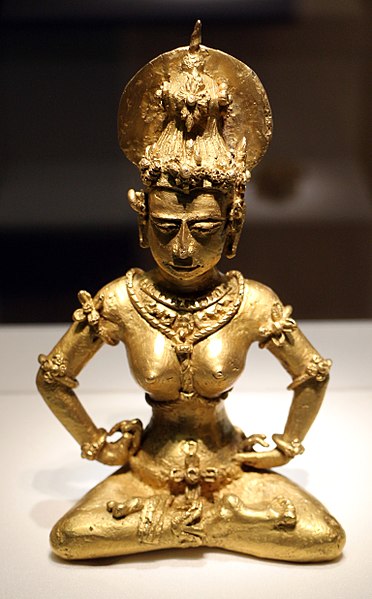Philippine mythology is rooted in the many indigenous Philippine folk religions. Philippine mythology exhibits influence from Hindu, Muslim, Buddhist, and Christian traditions.
Portrait of the first man, Malakas, and woman, Maganda, who came out from a bamboo pecked by the bird form of the deity of peace, Amihan, in Tagalog mythology
The Maranao people believe that Lake Lanao is a gap that resulted in the transfer of Mantapoli into the center of the world.
The Tagalog people's Obando Fertility Rites, before becoming a Catholic festival, was initially an animist ritual dedicated to the intersex deity, Lakapati, who presided over fertility, the goddess of love, Diyan Masalanta, and the supreme god, Bathala.
The Virgin of Antipolo has animist connections. Many of the rituals and prayers connected to the Lady of the Breadfruit (Tipolo) Tree have similarities to the pre-colonial indigenous cult of Maguayen, the Visayan god to whom people made offerings before building a boat or embarking on a voyage. Similarly, the Virgin of Antipolo is also asked for protection and well-being, as well as for the blessing of new cars, the modern mode of transportation.
Indigenous Philippine folk religions
Indigenous Philippine folk religions are the distinct native religions of various ethnic groups in the Philippines, where most follow belief systems in line with animism. Generally, these Indigenous folk religions are referred to as Anito or Anitism or the more modern and less ethnocentric Dayawism, where a set of local worship traditions are devoted to the anito or diwata, terms which translate to gods, spirits, and ancestors. 0.23% of the population of the Philippines are affiliated with the Indigenous Philippine folk religions according to the 2020 national census, an increase from the previous 0.19% from the 2010 census.
Mount Pulag is one of the many sacred grounds of adherents of the Indigenous Philippine folk religions. Ancestral spirits who guide their descendants are believed to reside throughout the mountain.
The Agusan image statue (900–950 CE) discovered in 1917 on the banks of the Wawa River near Esperanza, Agusan del Sur, Mindanao in the Philippines. Although having Hindu and Buddhist elements, locals worship it instead as a vessel for the animist gods. It is currently under the colonial possession of the American Field Museum, despite countless requests by locals to return the Image back home.
15th century Ifugao bulul with a pamahan (ceremonial bowl). Adherents of the folk religions believe that gods presiding over crops reside within their bululs. The sacred bulul in the photo is currently under the colonial possession of France's Louvre Museum.
One of the many Limestone tombs of Kamhantik (890–1030 AD), where ancestors were buried and sealed by sarcophagi. Locals believe that the tombs were also created by forest deities, as per tradition. In the early 20th century, the sacred site was looted and defiled by American colonizers. All of the sarcophagi seals were stolen in the process.








